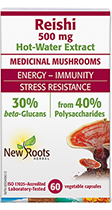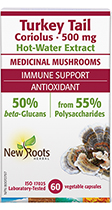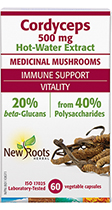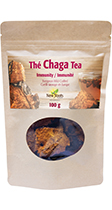Five Medicinal Mushrooms: Health Benefits
Mushrooms have been used medicinally for thousands of years, mainly due to the beneficial effects they confer on the immune system, nervous system, liver, and kidneys. Throughout China and Japan, mushrooms have long been a part of medicine, especially used as a tonic to support overall health. In recent years, medicinal mushrooms have gained popularity and are found as food, supplements, and beverages like tea and coffee.
The following is a list of five different medicinal mushrooms that have been used for hundreds of years to support health.
Chaga: A Mushroom for the Immune System
Chaga (Inonotus obliquus) has been used for its antioxidant, antitumour, and antiviral properties.
In the past few years, emerging research has shown chaga to reduce DNA damage due to inflammation in patients suffering from irritable bowel syndrome, decrease tumour size and metastasis in mice model lung carcinoma, protect the liver and decrease elevated liver enzymes, and protect from infection caused by the herpes simplex virus 1.
A word of caution about chaga mushrooms: There was one report of kidney issues due to high oxalate levels in the extract this person was taking and/or other confounding variables in their situation. The extraction methods can vary from company to company, and its important to consult with a health-care practitioner before taking mushrooms.
So, chaga may be helpful for those who are prone to HSV 1 infections, to support the immune system, and for those whose liver may need support due to inflammation in the body.
Cordyceps: A Mushroom for Your Lungs and Everything Else
Cordyceps sinensis, which is not taxonomically a mushroom, has been traditionally used as a panacea tonic—to improve energy, endurance, appetite, libido, and sleeping patterns. It supports the immune system, kidneys, and liver; and it has strong antioxidant and antitumour properties.
In China, research has shown that cordyceps decreases asthma symptoms and inflammation while improving lung function and quality of life in patients suffering from moderate to severe asthma. In animal models, it has preserved pancreas cells in diabetics in addition to protecting the kidneys and liver, limited the amount of brain damage experienced after a stroke, and has been used as a treatment for tuberculosis in addition to conventional treatments.
So, cordyceps may be helpful for people with kidney disease, for those who have suffered or are at higher risk for hypoxia (altitude sickness, strokes, heart attack), and as a tonic for those who are suffering from chronic fatigue.
Coriolus: A Mushroom for the Immune System and Cancer
Coriolus versicolor, known as yun zhi in China, like the other mushrooms discussed, has immune-boosting, antioxidant, and antitumour effects. It is approved in China and Japan for cancer patients as an adjunct to chemotherapy and/or radiation.
Studies on this mushroom have corroborated antitumour effects in the lab against esophageal cancer and leukaemia; the compound largely responsible for this property is a polysaccharopeptide that activates immune cells and enhances the communication between them. Other research is being conducted on its antibacterial effects against bacteria such as Staphylococcus aureus and Salmonella enteritidis, its suppression of irritable bowel disease, and its role as an antioxidant and anti-inflammatory in the nervous system.
So, coriolus may be helpful as a supportive therapy for those undergoing certain types of cancer treatments and/or antimicrobial regimens, for irritable bowel disease, and as general immune support.
Lion’s Mane: A Mushroom for Your Nerves, Digestion, and Immunity
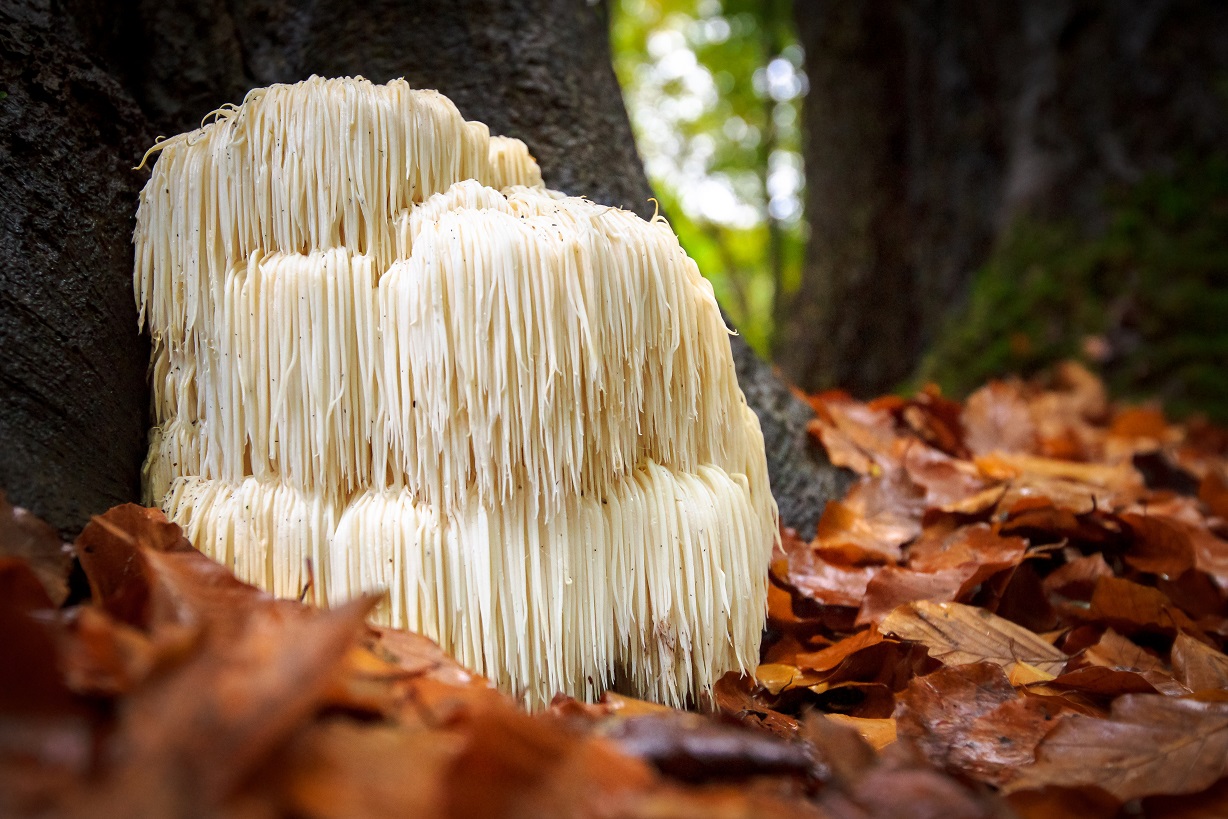 Lion’s mane (Hericium erinaceus) has traditionally been used to treat inflammation in the gut such as gastritis and ulcers, for its antitumour properties,
Lion’s mane (Hericium erinaceus) has traditionally been used to treat inflammation in the gut such as gastritis and ulcers, for its antitumour properties,
as well as for its protective effect on the nervous system. Its traditional uses are
now being corroborated by research in animal models: It contains extremely strong antioxidants, strengthens our immunity, has a protective effect on our gut lining, decreases the production of inflammatory markers in mice models of inflammatory bowel disease, can reduce lipid levels and induce weight loss after menopause, can decrease cholesterol and triglyceride levels in the blood, and protects the liver and enhances its role of detoxifying the body.
In the realm of the nervous system, lion’s mane has been shown to have neuroprotective effects for treating and preventing Alzheimer’s disease as well as Parkinson’s disease. In fact, it has recently been shown to improve recognition memory in normal animal models, as well as decrease the amount of time it took Alzheimer’s mice to fall asleep at night.
So, this mushroom may be helpful for those who have inflammation in their gut (IBD, gastritis, ulcers), for those suffering from Alzheimer’s and Parkinson’s, and for those who want some liver and immune support.
Reishi: A Mushroom for the Liver and Cancer
Reishi (Ganoderma lucidum) has been used traditionally for its antitumour and antioxidant properties. In Japan, it has been used as a liver tonic and for a healthy stress response.
Reishi has been shown to decrease tumour markers associated with a few different cancer cell lines such as melanoma, breast, colorectal, prostate, and nasopharyngeal. Human studies have shown it to protect our nervous systems from the effects of stress, decrease inflammatory markers in the nervous system in Parkinson’s disease, reverse a mildly fatty liver to its normal condition, boost a variety of different immune system cells, and have antidepressant and antianxiety effects.
So, reishi is a mushroom that may be helpful for those who have liver issues, Parkinson’s disease, and prolonged stress with anxiety and/or depression.
Conclusion
From these descriptions, one can gather that medicinal mushrooms have great potential in human health in regard to immunity and inflammation, especially since they can be used quite safely as an adjunct to conventional therapies in most cases. They all seem to confer great benefits to the nervous system and liver, possibly because these are areas of the body that are very easily affected by oxidative stress. However, different solvents extract different compounds in varying amounts from the mushrooms, and hence consulting with a health-care professional before taking any is important.
References
- Najafzadeh, M., et al. “Chaga mushroom extract inhibits oxidative DNA damage in lymphocytes of patients with inflammatory bowel disease.” BioFactors. 2007; 31(3-4): 191-200.
- Arata, S., et al. “Continuous intake of the chaga mushroom (Inonotus obliquus) aqueous extract suppresses cancer progression and maintains body temperature in mice.” Heliyon. Vol. 2, No. 5 (2016): e00111.
- Hong, K.B., et al. “Hepatoprotective activity of water extracts from chaga medicine mushroom, Inonotus obliquus (higher basidiomycetes) against tert-butyl hydroperoxide-induced oxidative liver injury in primary cultured rat hepatocytes.” International Journal of Medicinal Mushrooms. Vol. 17, No. 11 (2015): 1069–1076.
- Polkovnikova, M.V., et al. “[A study of the antiherpetic activity of the chaga mushroom (Inonotus obliquus) extracts in the Vero cells infected with type I herpes simplex virus]” (article in Russian). Voprosy Virusologii. Vol. 59, No. 2 (2014): 45–48.
- Kikuchi, Y., et al. “Chaga mushroom–induced oxalate nephropathy.” Clinical Nephrology. Vol. 81, No. 6 (2014): 440–444.
- Panda, A.K., and K.C. Swain. “Traditional uses and medicinal potential of Cordyceps sinensis of Sikkim.” Journal of Ayurveda and Integrative Medicine. Vol. 2, No. 1 (2011): 9–13.
- Wang, N., et al. “Herbal medicine Cordyceps sinensis improves health-related quality of life in moderate-to-severe asthma.” Evidence-Based Complementary and Alternative Medicine. Vol. 2016 (2016): 6134593.
- Kan, W., et al. “Effects of extract from solid-state fermented Cordyceps sinensis on type 2 diabetes mellitus.” Evidence-Based Complementary and Alternative Medicine. Vol. 2012 (2012): 743107.
- Liu, Z., et al. “Protective effect of extract of Cordyceps sinensis in middle cerebral artery occlusion-induced focal cerebral ischemia in rats.” Behavioral and Brain Functions. Vol. 6 (2010): 61.
- Li, D.G., and Z.X. Ren. “Cordyceps sinensis promotes immune regulation and enhances bacteriostatic activity of PA-824 via IL-10 in Mycobacterium tuberculosis disease.” Brazilian Journal of Medical and Biological Research. Vol. 50, No. 9 (2017): e6188.
- Saleh, M.H., I. Rashedi, and A. Keating. “Immunomodulatory properties of Coriolus versicolor: The role of polysaccharopeptide.” Frontiers in Immunology. Vol. 8 (2017): 1087.
- Hseih, T.C., and J.M. Wu. “Regulation of cell cycle transition and induction of apoptosis in HL-60 leukemia cells by the combination of Coriolus versicolor and Ganoderma lucidum.” International Journal of Molecular Medicine. Vol. 32, No. 1 (2013): 251–257.
- Wang, D.F., N. Lou, and X.D. Li. “Effect of Coriolus versicolor polysaccharide-B on the biological characteristics of human esophageal carcinoma cell line eca109.” Cancer Biology & Medicine. Vol. 9, No. 3 (2012): 164–167.
- Chang, Y., et al. “Preclinical and clinical studies of Coriolus versicolor polysaccharopeptide as an immunotherapeutic in China.” Discovery Medicine. Vol. 23, No. 127 (2017): 207–219.
- Matijasevic, D., et al. “The antibacterial activity of Coriolus versicolor methanol extract and its effect on ultrastructural changes of Staphylococcus aureus and Salmonella enteritidis.” Frontiers in Microbiology. Vol. 7 (2016): 1226.
- Lim, B.O. “Coriolus versicolor suppresses inflammatory bowel disease by inhibiting the expression of STAT1 and STAT6 associated with IFN-γ and IL-4 expression.” Phytotherapy Research. Vol. 25, No. 8 (2011): 1257–1261.
- Trovato, A., et al. “Redox modulation of cellular stress response and lipoxin A4 expression by Coriolus versicolor in rat brain: Relevance to Alzheimer’s disease pathogenesis.” Neurotoxicology. Vol. 53 (2016): 350–358.
- Jiang, S., Y. Wang, and X. Zhang. “Comparative studies on extracts from Hericium erinaceus by different polarity reagents to gain higher antioxidant activities.” Experimental and Therapeutic Medicine. Vol. 12, No. 1 (2016): 513–517.
- Zhang, J., et al. “The neuroprotective properties of Hericium erinaceus in glutamate-damaged differentiated PC12 cells and an Alzheimer’s disease mouse model.” International Journal of Molecular Sciences. Vol. 17, No. 11 (2016): pii: E1810.
- Wang, M., et al. “A unique polysaccharide purified from Hericium erinaceus mycelium prevents oxidative stress induced by H2O2 in human gastric mucosa epithelium cell.” PLoS One. Vol. 12, No. 7 (2017): e0181546.
- Sheng, X., et al. “Immunomodulatory effects of Hericium erinaceus–derived polysaccharides are mediated by intestinal immunology.” Food & Function. Vol. 8, No. 3 (2017): 1020–1027.
- Hiraki, E., et al. “Anti-obesity activity of yamabushitake (Hericium erinaceus) powder in ovariectomized mice, and its potentially active compounds.” Journal of Natural Medicines. Vol. 71, No. 3 (2017): 482–491.
- Cui, F., et al. “Protective effects of extracellular and intracellular polysaccharides on hepatotoxicity by Hericium erinaceus.” Current Microbiology. Vol. 73, No. 3 (2016): 379–385.
- Trovato, A., et al. “Redox modulation of cellular stress response and lipoxin A4 expression by Hericium erinaceus in rat brain: Relevance to Alzheimer’s disease pathogenesis.” Immunity & Ageing. Vol. 13 (2016): 23.
- Furuta, S., et al. “Hericium erinaceus extracts alter behavioral rhythm in mice.” BioMed Research International. Vol. 37, No. 4 (2016): 227–232.
- Brandalise, F., et al. “Dietary supplementation of Hericium erinaceus increases mossy fiber-CA3 hippocampal neurotransmission and recognition memory in wild-type mice.” Evidence-Based Complementary and Alternative Medicine. Vol. 2017 (2017): 3864340.
- Zheng, D.S., and L.S. Chen. “Triterpenoids from Ganoderma lucidum inhibit the EBV antigens as telomerase inhibitors.” Experimental and Therapeutic Medicine. Vol. 14, No. 4 (2017): 3273–3278.
- Wang, X.L., et al. “Efficient accumulation and in vitro antitumor activity of triterpene acids from submerged batch—Cultured reishi medicinal mushroom, Ganoderma lucidum.” International Journal of Medicinal Mushrooms. Vol. 19, No. 5 (2017): 419–431.
- Na, K., et al. “Anticarcinogenic effects of water extract of sporoderm-broken spores of Ganoderma lucidum on colorectal cancer in vivo.” International Journal of Oncology. Vol. 50, No. 5 (2017): 1541–1554.
- Zhang, Y. “Ganoderma lucidum (reishi) suppresses proliferation and migration of breast cancer cells via inhibiting Wnt/B-catenin signaling.” Biochemical and Biophysical Research Communications. Vol. 488, No. 4 (2017): 679–684.
- Barbieri, A., et al. “Anticancer and anti-inflammatory properties of Ganoderma lucidum extract effects on melanoma and triple-negative breast cancer treatment.” Nutrients. Vol. 9, No. 3 (2017): pii: E210.
- Sun, X.Z., et al. “Neuroprotective effects of Ganoderma lucidum polysaccharides against oxidative stress-induced neuronal apoptosis.” Neural Regeneration Research. Vol. 12, No. 6 (2017): 953–958.
- Chiu, H.F., et al. “Triterpenoids and polysaccharide peptides-enriched Ganoderma lucidum: A randomized, double-blind placebo-controlled crossover study of its antioxidation and hepatoprotective efficacy in volunteers.” Pharmaceutical Biology. Vol. 55, No. 1 (2017): 1041–1046.
 Anne Hussain, ND
Anne Hussain, ND
Dr. Anne is passionate about helping people live healthier
and fuller lives, and loves helping women feel strong and
vibrant about their bodies inside and out.
www.annehussain.com

 Stores
Stores
